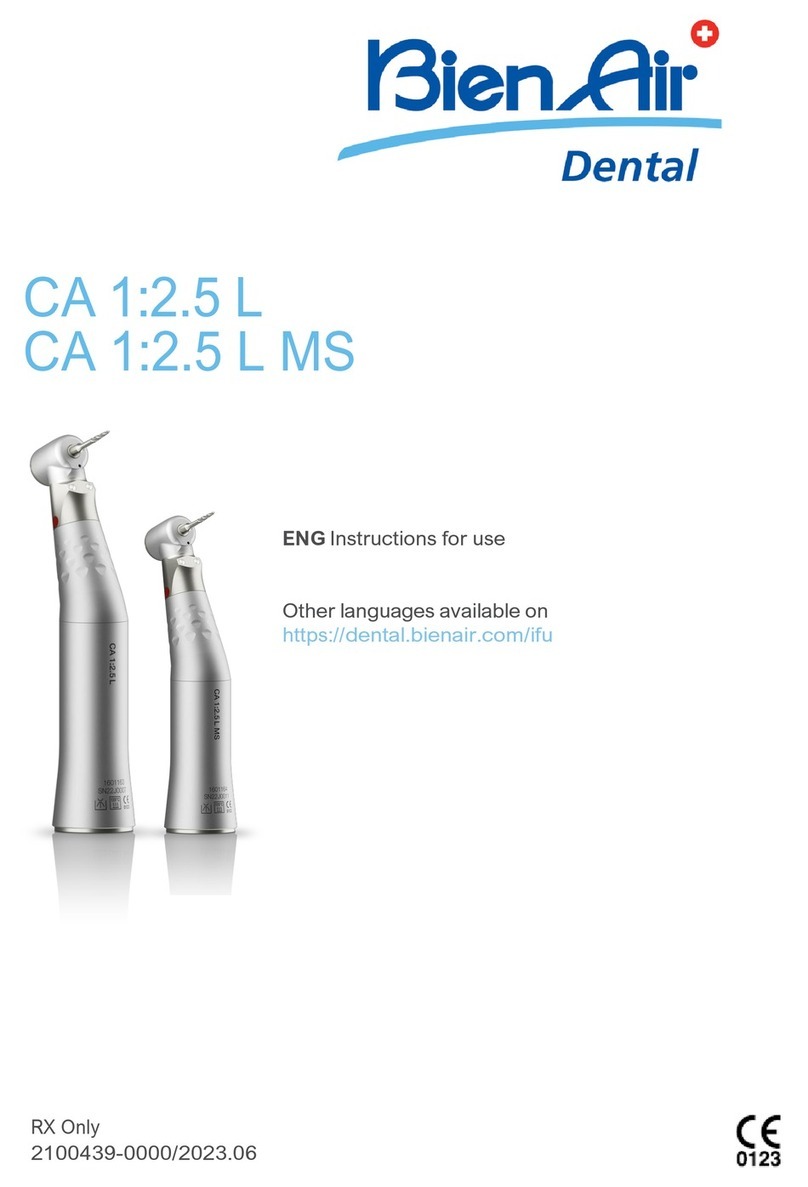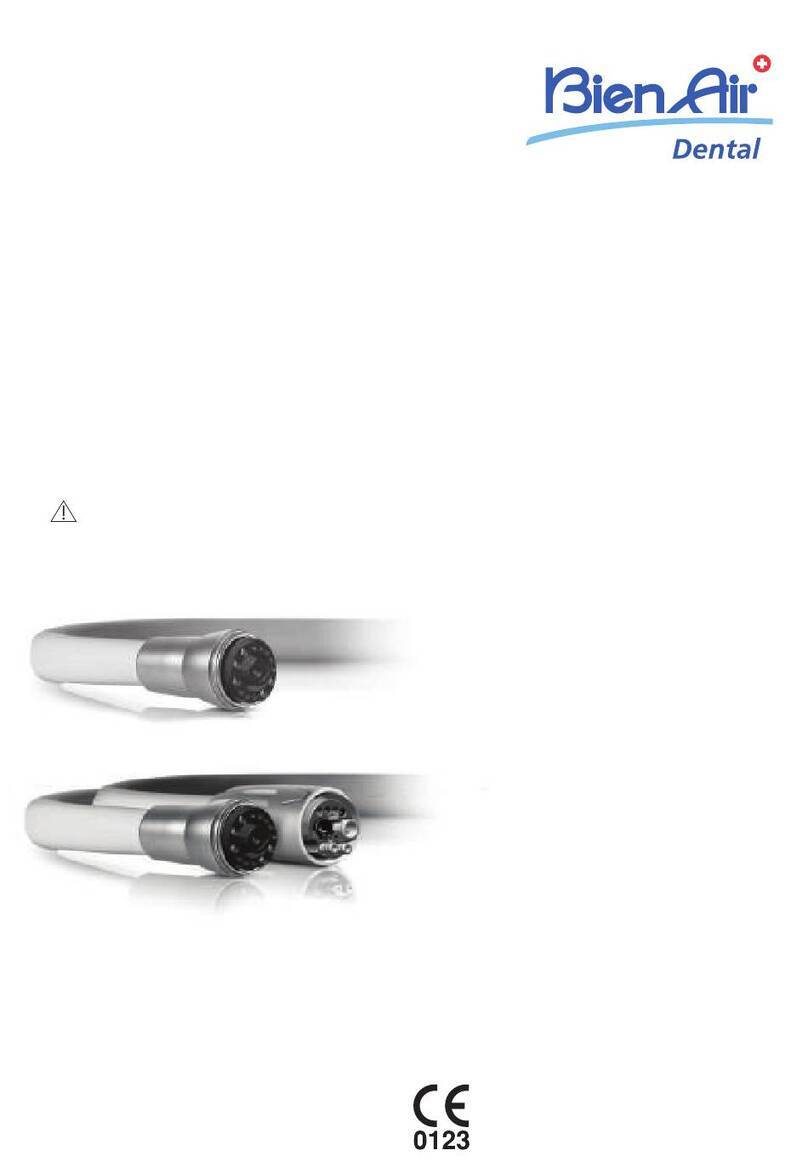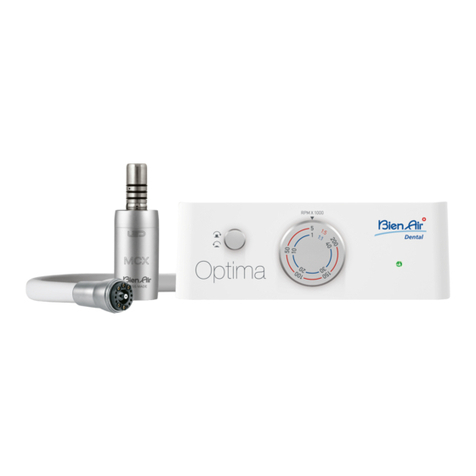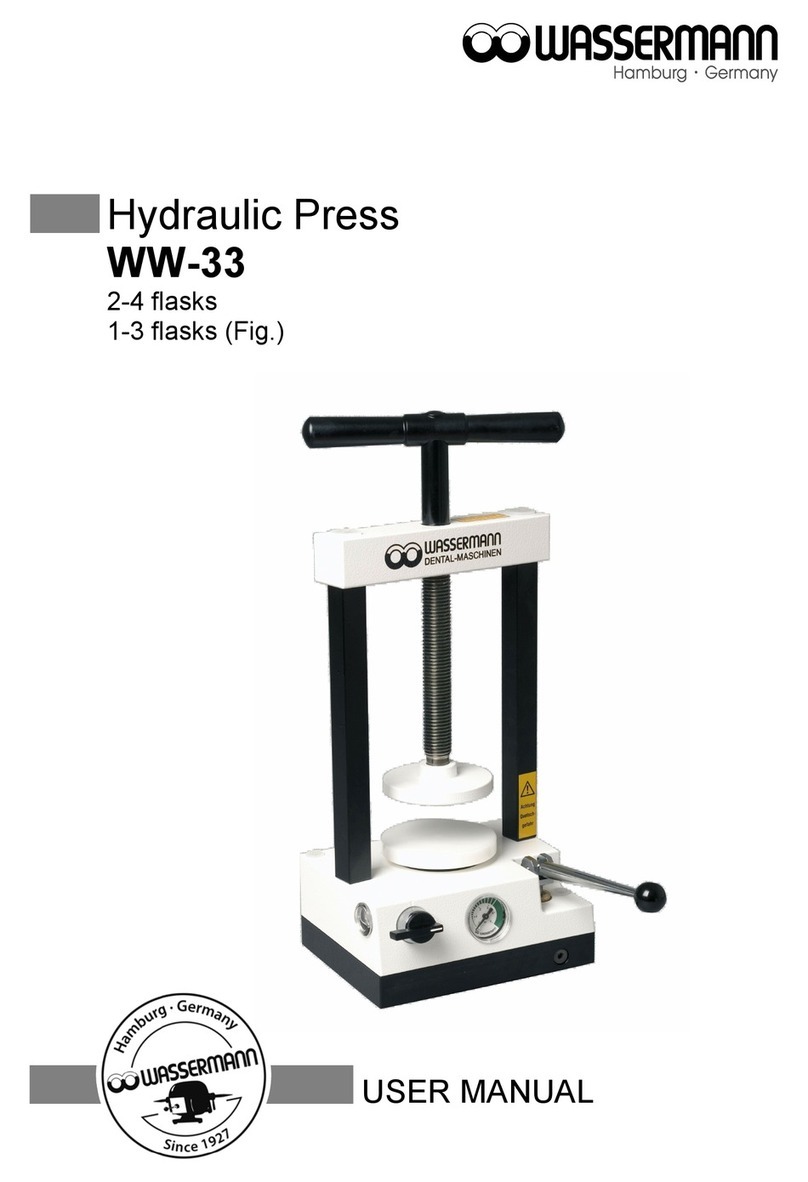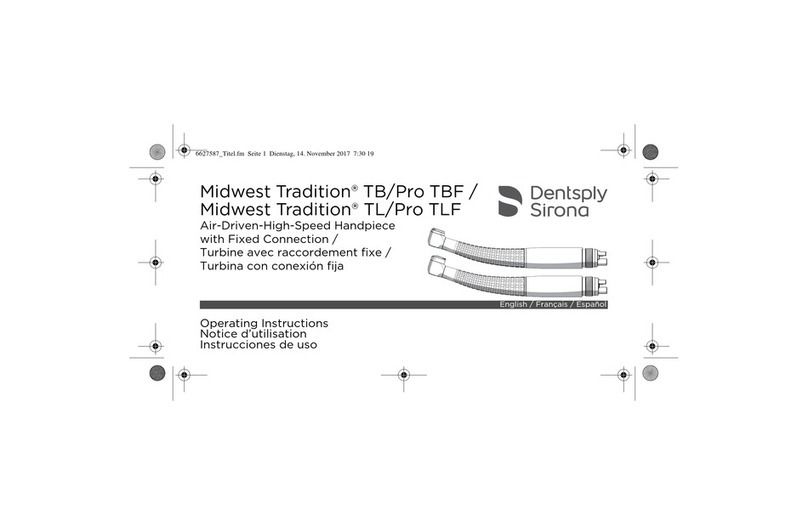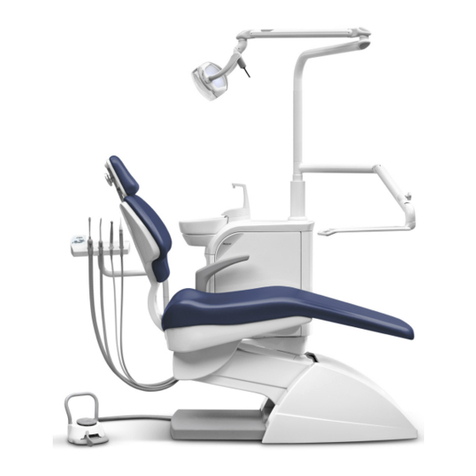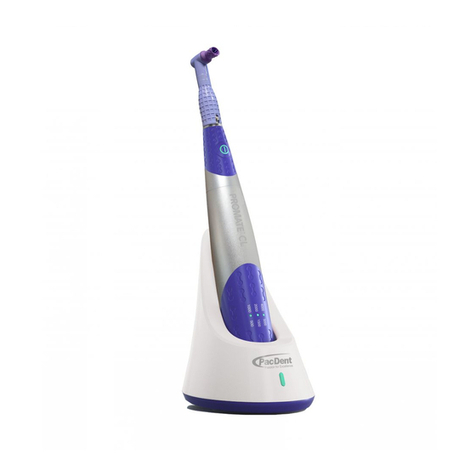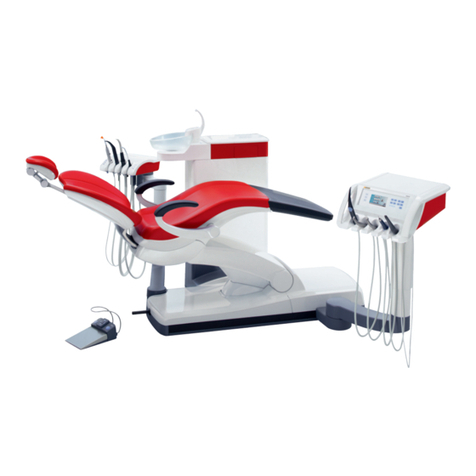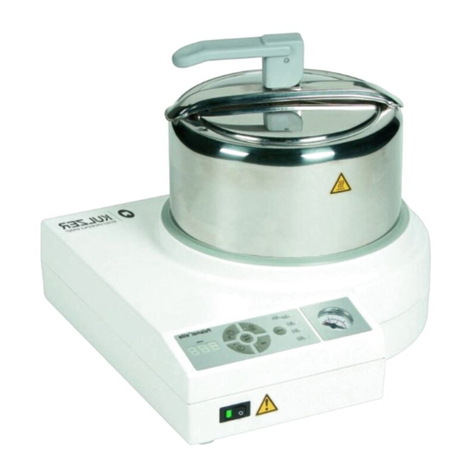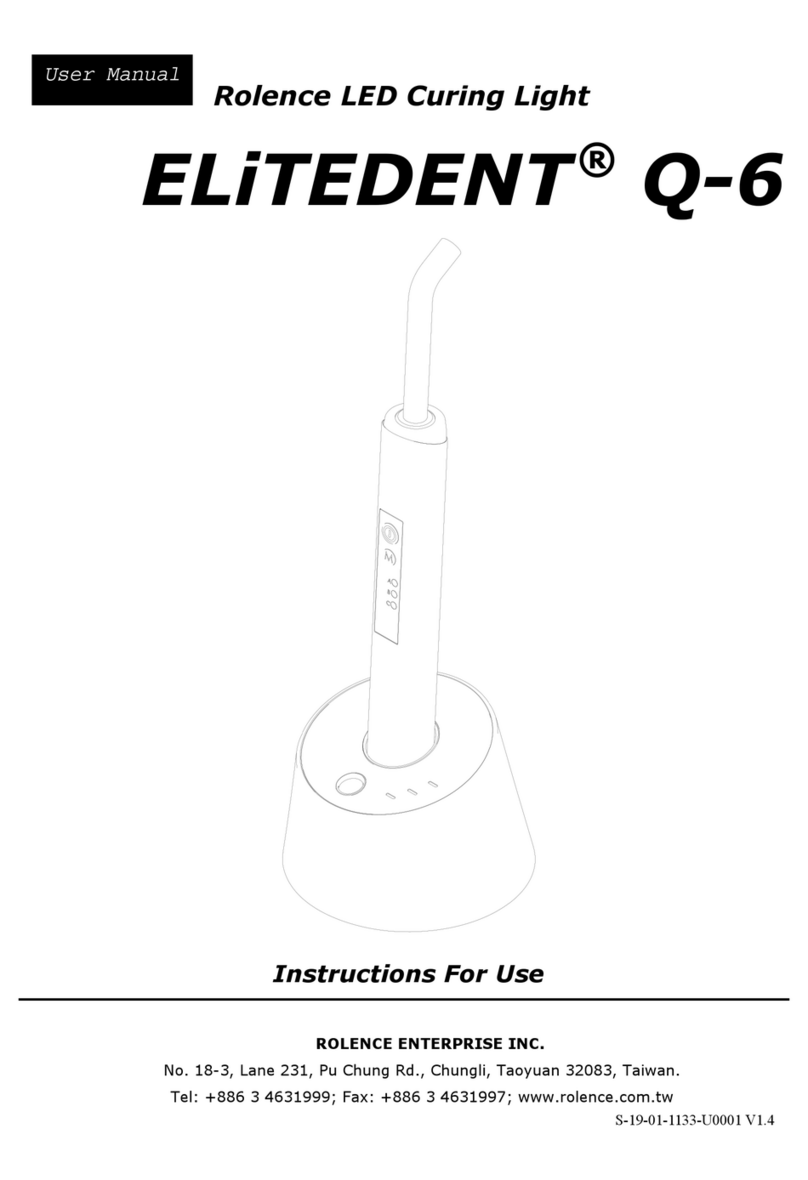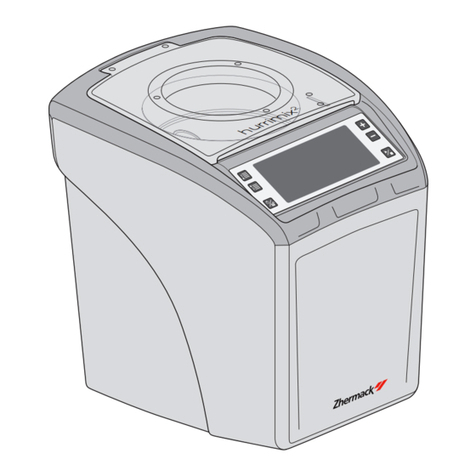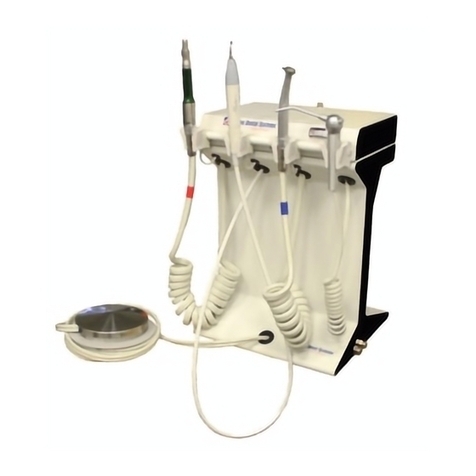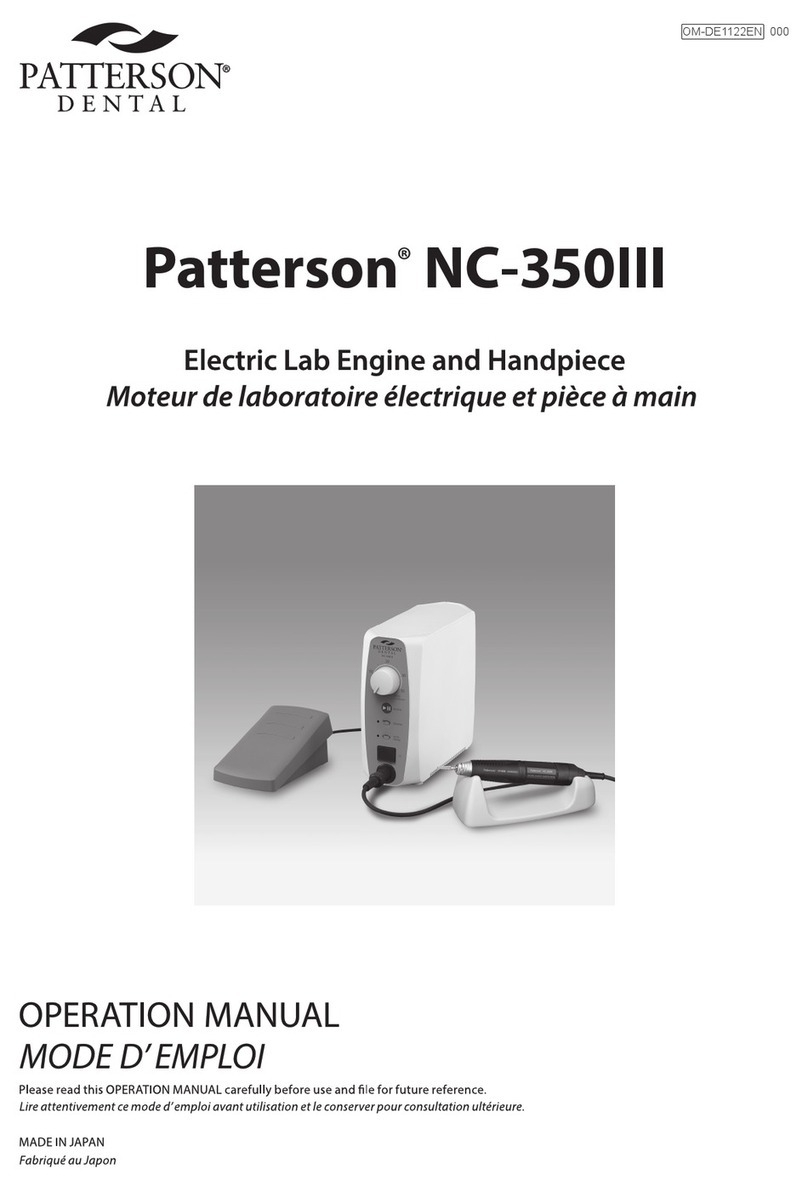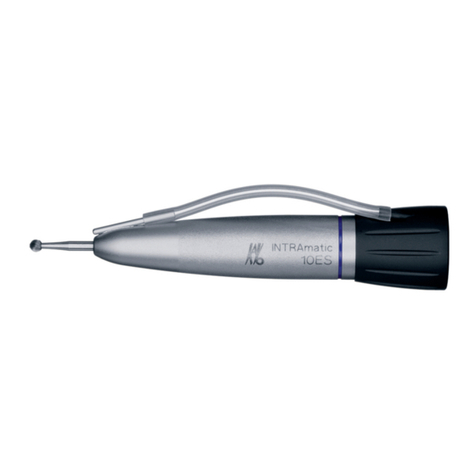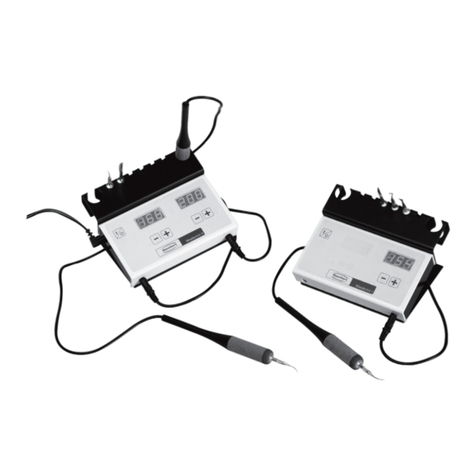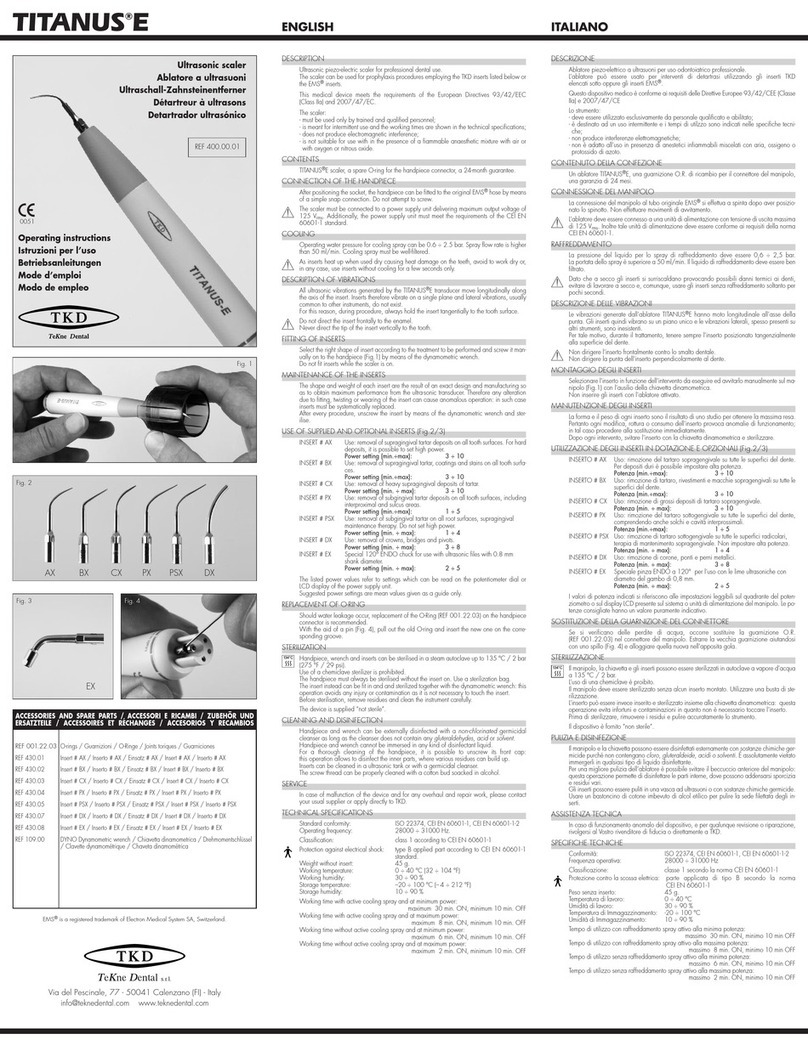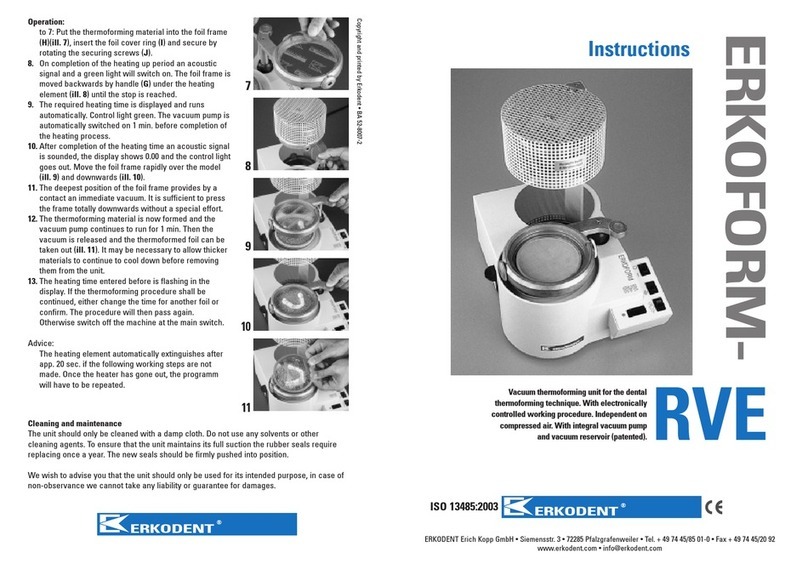Bien-Air Dental CA NOVA 1:1L User manual

CA NOVA1:1L
CA 1:1 L EVO15
CA 1:1
HP 1:1
CA NOVA1:5L
CA 1:5 L EVO15
CA 1:5
CA 10:1
ENG INSTRUCTIONS FOR USE.
Other languages available on www.bienair.com/ifu
Rx Only
REF 2100294-0003/2020.03

REF 2100294-0003/2020.03 CA 1:1,CA 1:5,CA 10:1,EVO15,NOVA,HP 1:1 • © Bien-Air Dental
Set supplied (REF) CA 1:5
CA NOVA1:5L
1601139-001
CA NOVA1:5L MS
1601138-001
CA 1:5 L EVO15
1600941-001
CA 1:5 L EVO15 MS
1600940-001
CA 1:5 L
1600386-001
CA 1:5
1600325-001
CA 1:5 L MS
1600690-001
Set supplied (REF) CA 1:1
CA NOVA1:1L
1601137-001
CA NOVA1:1L MS
1601136-001
CA 1:1 L EVO15
1600939-001
CA 1:1 L EVO15 MS
1600938-001
CA 1:1 L
1600384-001
CA 1:1
1600424-001
CA 1:1 L MS
1600691-001
Set supplied (REF) CA 10:1
CA 10:1 L
1600385-001
CA 10:1
1600425-001
Set supplied (REF) HP 1:1
HP 1:1
1600383-001
HP 1:1 MS
1600693-001
Optional accessories (REF)
1600036-006 1600064-006 1000001-010

1 Symbols 4
1.1 Description of symbols used 4
2 Identification & Intended Use 5
2.1 Identification 5
2.2 Classification 6
2.3 Intended use 6
3 Precautions for use 7
4 Description 8
4.1 Overview 8
4.2 Technical data 9
5 Operation 11
5.1 Changing the bur 11
6 Cleaning and servicing 13
6.1 Maintenance - General in-
formation 13
6.1.1 Precautions for maintenance 13
6.1.2 Suitable maintenance products 13
6.2 Cleaning 14
6.3 Disinfection 15
6.3.1 Manual cleaning / disinfection 15
6.3.2 Automatic disinfection 15
6.4 Lubrication 17
6.4.1 Verifying cleanliness 17
6.4.2 Lubrication 17
6.5 Sterilisation 17
6.6 Packing 18
6.7 Servicing 18
7 Transport& disposal 18
7.1 Transport and storage con-
ditions after first use 18
7.2 Disposal 18
8 General information 19
8.1 Terms of guarantee 19
8.2 References 19
8.2.1 Set supplied (see cover) 19
8.2.2 Set supplied for students 20
8.2.3 Optional accessories (see cover) 20
3
Table of contents

4
ENG INSTRUCTIONS FOR USE
1 Symbols
1.1 Description of symbols used
Sym Description Sym Description
Manufacturer. Reference number.
CE Marking with number of the notified
body. Serial number.
WARNING:hazard that could result in ser-
ious injury or damage to the device if the
safety instructions are not correctly fol-
lowed .
Medical Device.
CAUTION:hazard that could result in light
or moderate injury or damage to the
device if the safety instructions are not cor-
rectly followed.
Recyclable materials.
Use rub ber gloves. After initial mechanical resistance, tighten
fully in the direction indicated.
Thermo washer disinfectable. Sterilisation up to the specified tem-
perature.
Movement in the d irection
indicated.
Movement to the stop in the direction in-
dicated.
Back and forth movement. Light.
Warning: in accordance with federal law
(USA), this device is only available for sale
upon recommendation by an accredited
practitioner.
Refer to the accompanying
documents.

ENG
5
2 Identification & Intended Use
2.1 Identification
Medical devices manufactured in Switzerland by Bien-Air Dental SA.
Type
Dental contra-angles handpieces (CA), push-button bur locking, with or without
light, with 3 internal sprays (CA 1:1, CA 10:1, CA 1:5), 4 mixed sprays on the EVO15
range and NOVA 1:5, 1 separated spray on the NOVA 1:1. Dental straight hand-
pieces (HP), locking ring, with 1 separated spray, without light, direct ratio 1:1.
See the table below for a summary of your handpiece type.
Contra-angle Light Sprays
Ratio With
light
Without
light
4
mixed
sprays
3 separated
spray
1 separated
spray
●CA NOVA1:5L ● ●
●CA NOVA1:5L MS ● ●
●CA 1:5 L EVO15 ● ●
●CA 1:5 L EVO15 MICRO-SERIES ● ●
●CA 1:5 L ● ●
●CA 1:5 ● ●
●CA 1:5 L MICROSERIES ● ●
●CA NOVA1:1L ● ●
●CA NOVA1:1L MS ● ●
●CA 1:1 L EVO15 ● ●
●CA 1:1 L EVO15 MICRO-SERIES ● ●
●CA 1:1 L ● ●
●CA 1:1 ● ●
●CA 1:1 L MICRO-SERIES ● ●
●CA 10:1 L ● ●
●CA 10:1 ● ●
●HP 1:1 ● ●
●HP 1:1 MICRO-SERIES ● ●

2.2 Classification
Class IIa according to European Dir-
ective 93/42/EEC relating to medical
devices. Those medical devices comply
with the legislation in force.
2.3 Intended use
Products intended for professional use
only. Used in general dentistry:
lNOVA 1:1L, EVO15 1:1, CA 1:1 and
CA 10:1 for prophylaxis, res-
toration and endodontics
procedures.
lNOVA 1:5L, EVO15 1:5, CA 1:5 and
HP 1:1 for restoration pro-
cedures.
WARNING
Any use other than that for which this
device is intended is prohibited and may
prove dangerous.
WARNING
The device must not be used if any open
lesions or damaged soft tissue are
present or if a recent extraction has
taken place. The air flow could propel in-
fected material into the wounds,
causing infection and a risk of em-
bolism.
6

ENG
3 Precautions for
use
Those medical devices must be used by
a competent person, in particular in
compliance with the legal provisions in
force regarding occupational safety,
health and accident prevention meas-
ures, and these instructions for use.
In accordance with these provisions, the
user is responsible for ensuring he or
she only uses devices which are in per-
fect working order.
In the event of irregular operation, ex-
cessive vibrations, abnormal heating,
unusual noise or other signs suggesting
that the device is malfunctioning, work
must be suspended immediately.
In this case, contact a repair centre ap-
proved by Bien-Air Dental SA.
WARNING
Medical personnel using or performing
maintenance on medical devices that
are contaminated or potentially con-
taminated must comply with universal
precautions, in particular the wearing
of personal protective equipment
(gloves, goggles, etc.). Pointed and
sharp instruments should be handled
with great care.
CAUTION
Any excess maintenance product (lub-
ricant, cleaning and disinfection
products) present on the handpiece
could find its way into the electric brush
motor and adversely affect its op-
eration. Always observe the
maintenance instructions provided with
each product.
CAUTION
It is essential to use dry, purified com-
pressed air in order to ensure the long
working life of the device. Maintain the
quality of the air and the water by reg-
ular maintenance of the compressor
and the filtration systems. The use of un-
filtered hard water will lead to early
blockage of the tubes, connectors and
spray cones.
Note: the technical specifications, il-
lustrations and dimensions contained in
these instructions are given merely as
an indication. They may not give rise to
any claim.
For any further information, please con-
tact Bien-Air Dental SA at the address
given on the back cover.
7

ENG
9
4.2 Technical data
Contra-angle 1:1 1:5 10:1
Standard coupling ISO 3964*
Transmission ratio Direct ratio,
blue clip
Speed increasing ratio
of 5, red clip
Speed d ecreasing ratio of
10, green clip
Motor drive speed 40’000 rpm max.
Speed of rotation 40'000 rpm
max. 200 '000 rpm max. 4'000 rpm max.
Typical operating torque 3 Ncm 1 Ncm 3 Ncm
Recommended cooling Air consumption
(measured at the motor nose) 8 - 10 Nl/min
Cooling air pressure 250 - 490 kPa**
Spray water flow at 200 kPa Min. 60 ml/min**
Spray air flow at 200 kPa Min. 2 Nl/min**
Recommended spray water pressure (for an
op timal cooling mist) 100-200 kPa
Recommended spray air pressure (for an op-
timal cooling mist) 200-400 kPa
*CA NOVA 1:5L MS, CA NOVA 1: 1L MS, CA 1:5 L EVO15 MICRO-SERIES, CA 1:1 L EVO15 MICRO-SERIES, CA 1:5
L MICRO-SERIES, CA 1:1 L MICRO-SERIES and HP 1:1 MICRO-SERIES can only be operated on dental motors
with an ISO coup ling measuring no longer than 23 mm.
**Equip ped with e.g. the MX2 micromotor.

Bur chuck
FIG.2
Shaft diameter 2.35 mm, type 1 as per
ISO 1797-1, max length 22 mm, code 4
as per ISO 6360-1 for the CA 1:1 and
the CA 10:1 range (max. working dia-
meter 3 mm). Shaft diameter 1.60 mm,
type 3 as per ISO 1797- 1, max length
21 mm, code 4-5 as per ISO 6360-1 for
the CA 1:5 range (max. working dia-
meter 2 mm).
FIG.3
Shaft diameter 2.35 mm, type 2 as per
ISO 1797- 1, max length 44.5 mm, code
4 as per ISO 6360- 1 for the HP 1:1
(max. working diameter 3 mm).
WARNING
Follow the guidelines for use, according
to the bur manufacturer's instructions.
Never use a bur if the shaft is not com-
pliant, as there is a risk it can become
detached during the procedure and in-
jure the practitioner, the patient or
third parties.
10
FIG.2 FIG.3

ENG
5 Operation
5.1 Changing the bur
CA NOVA1:1L, CA NOVA1:5L, CA 1:1,
CA 1:5, CA 10:1, CA 1:1 L EVO15 and CA
1:5 L EVO15
FIG.4
Push-button bur locking.
1. Press the push-button and sim-
ultaneously pull out the bur.
2. Press the push-button, insert the new
bur all the way to the stop and re-
lease the push-button. For the CA 1:1
and CA 10:1 range, rotate the bur in-
side the chuck system until its
orientation is indexed according to
the tightening.
3. Check that the bur rotates freely and
that it is locked by gently pushing and
pulling the bur.
HP 1:1
FIG.5
1. Rotate the sleeve and remove the
bur.
2. Fully insert the bur in the chuck sys-
tem. Lock the bur changing
mechanism by fully rotating the
sleeve, it will only be fully tightened if
the initial mechanical resistance is
forced and the sleeve meets the
mechanical abutment.
3. Check that the bur rotates freely and
that it is locked by gently pushing and
pulling the bur.
11
FIG.4 FIG.5

CAUTION
Never insert or remove a device while
the micromotor is rotating.
WARNING
Do not touch the dental bur while it is ro-
tating.
WARNING
Never push the push-button while the
CA is in operation. Never rotate the lock-
ing ring on an operating HP.
CAUTION
Always check that the bur is in place
and rotates freely. If it is blocked, con-
tact your usual supplier or Bien- Air
Dental SA for repair.
WARNING
Always ensure that the coolant supply is
sufficient and adequate. Failure to com-
ply with this recommendation may
result in overheating and burns or
product damage.
CAUTION
Always ensure that the spray outlets
are not obstructed.
WARNING
Never touch soft tissue with the hand-
piece head. The improper use of the
device could lead to burns or injuries.
12

ENG
6 Cleaning and
servicing
6.1 Maintenance - General in-
formation
WARNING
The instrument is supplied "non sterile".
Clean, lubricate and sterilise the device
prior to first use and between each pa-
tients.
6.1.1 Precautions for maintenance
lBefore using for the first time and
within a maximum of 30 minutes
after each treatment, clean, dis-
infect and lubricate the
instrument, then sterilise. Ob-
serving this procedure eliminates
any blood, saliva or saline solution
residues and prevents the trans-
mission system from being
blocked.
lOnly use original Bien-Air Dental
SAmaintenance products and
parts or those recommended by
Bien-Air Dental SA.For suitable
maintenance products refer to
section 6.1.2 Suitable main-
tenance products. Using other
products or parts may cause
faults during operation and/or
void the warranty.
CAUTION
lCarry out cleaning and ster-
ilisation without a bur in the chuck
mechanism.
lUse detergents that are pH 8-11,
are not corrosive nor contain
chlorine or acetone and/or al-
dehydes.
lDo not submerge in physiological
liquid (NaCl) nor use saline to
keep the device moist until it can
be cleaned.
lClean using manual cleaning or
automated washer/disinfector
only (do not use ultrasonic
cleaner). Only instruments
marked with the logo can be
cleaned in a washer-disinfector
machine.
lAs with all instruments, following
each sterilization cycle, including
drying, remove the device to avoid
excess exposure to heat which
can result in corrosion.
lUse only dynamic sterilizers: do
not use a steam steriliser with a
gravity displacement system.
6.1.2 Suitable maintenance products
Preliminary cleaning
Tap water if the local tap water has pH
within the range 6.5 - 8.5 and chloride
content below 100 mg/l. If the local tap
water does not meet these re-
quirements, use demineralized
(deionized) water instead.
Manual cleaning-disinfection:
lAlkaline detergent or detergent-
disinfectant (pH 8-11) re-
commended for cleaning-
disinfection of dental or surgical in-
struments. Disinfectant products
composed either of di-
decyldimethylammonium
chloride, quaternary ammonium
carbonate or neutral enzymatic
product. (e.g. Neodisher® med-
iclean) are also allowable.
lSpraynet.
Automatic cleaning-disinfection:
lUse an alkaline product re-
commended for cleaning in a
washer-disinfector for dental or
surgical instruments (pH 8-11).
13

6.2 Cleaning
Preparation
1. Disconnect the device from the elec-
trical motor and remove the bur
(FIG.4 step 1).
CAUTION
If there is a large amount of debris,
clean the exterior of the device with dis-
infectant wipes. Observe the
instructions given by the manufacturer.
Remove dirt / deposits
FIG.6,FIG.7
1. Clean the exterior and interior of the
device under tap water at 15°C-38°C
(59°F-100°F) if local tap water has
pH within the range 6.5 - 8.5 and
chloride content below 100 mg/l. If
local tap water does not meet the re-
quirements, use demineralized
(deionized) water instead.
2. Carefully remove all traces of dirt or
deposits from the nozzles using the
Bien-Air cleaning wire (optional).
14
EVO15
CA 1:1, 1:5, 10:1
FIG.6
NOVA 1:1
HP 1:1
FIG.7

ENG
6.3 Disinfection
6.3.1 Manual cleaning / disinfection
1. Dip the device in a bath containing a
disinfectant product (e.g. di-
decyldimethylammonium chloride,
quaternary ammonium carbonate or
neutral enzymatic product which are
allowable chemical agents). Follow
the concentration and duration re-
commended by the fabricant of the
disinfection product.
2. Brush the device with a smooth, flex-
ible brush (e.g. soft-bristled
toothbrush). DO NOT USE a wire
brush.
3. Optional: perform additional cleaning
and disinfection of the external sur-
faces with non-woven wipes
impregnated with a disinfection
product (e.g. di-
decyldimethylammonium chloride).
4. Rinse twice the device with running
tap water (15°C-38°C) if local tap wa-
ter has pH within the range 6.5 - 8.5
and chloride content is below 100
mg/l. If local tap water does not
meet the requirements, use de-
mineralized (deionized) water
instead.
5. After selecting the appropriate
nozzle, spray inside the device with
Spraynet (FIG.8).
6. Dry the external surfaces with sterile
non-woven compresses (low linting
textiles).
6.3.2 Automatic disinfection
CAUTION
Only for device engraved with
Note: the automatic cleaning- dis-
infection can replace the previous steps
4 to 6.
Washer-disinfector
Carry out automatic cleaning- dis-
infection using an approved washer-
disinfector which complies with ISO
standard 15883-1.
Detergent and washing cycle
Use an alkaline or detergent re-
commended for cleaning in a washer-
disinfector for dental or surgical in-
struments (pH 8-11).
15
FIG.8

16
Recommended specifications for the thermo-disinfection cycle.
Phase Parameters
Pre-cleaning <45°C (113°F); ≥ 2 minutes
Cleaning 55°C-65°C (131°F-149°F); ≥ 5 minutes
Neutralization ≥ 2 minutes
Rinsing Tap water, ≤30°C (86°F), ≥ 2 minutes cold water
Thermal Disinfection Demineralized water, 90°C-95°C (194°F-203 °F), 5-10 minutes
Drying 18-22 minutes
CAUTION
Never cool devices by rinsing them.
CAUTION
If an automatic washer is used at the place of the washer/thermo-disinfector, re-
spect the previous program for the Pre-cleaning, Cleaning, Neutralization and
Rinsing phases. If local tap water has pH outside the range 6.5-8.5 or contains more
than 100 mg/l chloride (Cl-ion), do not dry the device inside the automatic washer
but dry it manually with low linting textiles.

ENG
6.4 Lubrication
6.4.1 Verifying cleanliness
Visually inspect the device to ensure it is
clean. Repeat the cleaning and dis-
infection procedure if necessary.
6.4.2 Lubrication
Lubricate before each sterilisation or at
least twice a day. Only the Lubrifluid
spray must be used.
FIG.9
1. Place the device in a sterile, non-
woven cloth to collect the excess of
lubricant.
2. Select the appropriate nozzle.
3. Insert the nozzle of the Lubrifluid can
in the rear of the device's handle.
4. Activate the spray for 1 second and
clean the excess oil on the exterior
with a sterile, non-woven compress.
6.5 Sterilisation
CAUTION
The quality of the sterilisation is highly
dependent on how clean the in-
strument is. Only perfectly clean
instruments should be sterilised.
CAUTION
Do not use a sterilisation procedure
other than the one described below.
Procedure
CAUTION
Pack the device in a packaging ap-
proved for steam sterilisation.
CAUTION
Only use dynamic air removal cycles:
pre- vacuum or steam flush pressure
pulse (SFPP) cycles.
Sterilise using steam, following dy-
namic air removal cycle (ANSI/AAMI
ST79, Section 2.19), i.e. air removal via
forced evacuation (ISO 17665- 1,
ISO/TS 17665-2) at 135°C (275°F), dur-
ing 3 minutes. In jurisdictions where
sterilization for prions is required, ster-
ilise at 135°C for 18 minutes.
17
FIG.9

The recommended parameters for the
sterilization cycle are:
lThe maximum temperature in the
autoclave chamber does not ex-
ceed 137°C, i.e. the nominal
temperature of the autoclave is
set at 134°C, 135°C or 135.5°C tak-
ing into account the uncertainty of
the sterilizer as regards tem-
perature.
lThe maximum duration of the in-
terval at the maximum
temperature of 137°C is in ac-
cordance with national
requirements for moist heat ster-
ilization and does not exceed 30
minutes.
lThe absolute pressure in the
chamber of the sterilizer is com-
prised in the interval 0.07 bar to
3.17 bar (1 psia to 46 psia).
lThe rate of change of tem-
perature does not exceed
15°C/min for increasing tem-
perature and -35°C/min for
decreasing temperature.
lThe rate of change of pressure
does not exceed 0.45 bar/min (6.6
psia/min) for increasing pressure
and -1.7 bar/min (-25 psia/min)
for decreasing pressure.
lNo chemical or physical reagents
are added to the water steam.
6.6 Packing
The device must be stored inside the
sterilisation pouch in a dry and dust-
free environment. The temperature
must not exceed 55°C (131°F). If the
device will not be used for 7 days or
more after the sterilisation, extract the
device from the sterilisation pouch and
store it in the original package. If the
device is not stored in a sterilisation
pouch or if the pouch is no longer
sterile, clean, lubricate and sterilise the
device before using it.
CAUTION
If the medical device has been stored re-
frigerated, allow it to warm up to room
temperature prior to its use.
CAUTION
Comply with the expiration date of the
sterilised items which depends on the
storage conditions and type of pack-
aging.
6.7 Servicing
Note: Bien-Air Dental SArecommends
that the user has his or her dynamic
devices checked or serviced every
three years.
7 Transport
& disposal
7.1 Transport and storage
conditions after first use
Follow the general requirements ap-
plicable for micromechanical devices.
7.2 Disposal
The disposal and/or recycling of ma-
terials must be performed in
accordance with the legislation in force.
All contra-angles and handpieces must
be recycled. In order to avoid any risk of
contamination, the user must return
the device sterilised to his dealer or con-
tact an authorized body for the
treatment and recovery of this type of
equipment.
18

ENG
8 General
information
8.1 Terms of guarantee
Bien-Air Dental SA grants the user a
warranty covering any operating fault,
or material or manufacturing defect.
The warranty period is:
l12 months for the CA 10:1 range
l24 months for the CA 1:1, CA 1:5,
HP 1:1, EVO15 and NOVA ranges
from the date of invoicing.
In the event of a justified claim, Bien-Air
Dental SAor its authorised rep-
resentative will repair or replace the
product free of charge.
All other claims of any kind whatsoever,
particularly claims for damages, are ex-
cluded.
Bien-Air Dental SAcannot be held li-
able for damage or injury and the
consequences thereof, resulting from:
lExcessive wear and tear
lInfrequent or improper use
lFailure to observe the servicing,
assembly or maintenance in-
structions
lDamage caused by unusual chem-
ical, electrical or electrolytic
influences
lFaulty air, water or electrical con-
nections.
CAUTION
The warranty becomes null and void if
damage and its consequences result
from incorrect servicing or modification
by third parties not authorised
by Bien-Air Dental SA.
Warranty requests will only be taken
into consideration if the product is ac-
companied by a copy of the invoice or
delivery note. The following information
must be clearly indicated: purchase
date, product reference and serial num-
ber.
8.2 References
8.2.1 Set supplied (see cover)
REF Legend Ratio
1601139-001 CA NOVA1:5L* ●
1601138-001 CA NOVA1:5L MS* ●
1600941-001 CA 1:5 L EVO15* ●
1600940-001 CA 1:5 L EVO15
MICRO-SERIES* ●
1600386-001 CA 1:5 L* ●
1600325-001 CA 1:5 ●
1600690-001 CA 1:5 L
MICROSERIES* ●
1601137-001 CA NOVA1:1L* ●
1601136-001 CA NOVA1:1L MS* ●
1600939-001 CA 1:1 L EVO15* ●
1600938-001 CA 1:1 L EVO15
MICRO-SERIES* ●
1600384-001 CA 1:1 L* ●
1600424-001 CA 1:1 ●
1600691-001 CA 1:1 L
MICRO-SERIES* ●
1600385-001 CA 10:1 L* ●
1600425-001 CA 10:1 ●
1600383-001 HP 1:1 ●
1600693-001 HP 1:1 MICRO-SERIES ●
*With light.
19

8.2.2 Set supplied for students
SET 1700793
REF Legend Ratio
1600052-001 PM 1:1 EXT SPRAY ●
1600677-001 MC MX2
1600691-001 CA 1:1 L
MICRO-SERIES* ●
1601138-001 CA NOVA1:5L MS* ●
SET 1700794
REF Legend Ratio
1600052-001 PM 1:1 EXT SPRAY
MICRO-SERIES* ●
1600940-001 CA 1:5 L EVO15
MICRO-SERIES* ●
1600691-001 CA 1:1 L
MICRO-SERIES* ●
SET 1700795
REF Legend Ratio
1600052-001 PM 1:1 EXT SPRAY
MICRO-SERIES* ●
1601138-001 CA NOVA1:5L MS* ●
1600691-001 CA 1:1 L
MICRO-SERIES* ●
SET 1700796
REF Legend Ratio
1600052-001 PM 1:1 EXT SPRAY
MICRO-SERIES* ●
1600677-001 MC MX2
1600938-001 CA 1:1 L EVO15
MICRO-SERIES* ●
1601138-001 CA NOVA1:5L MS* ●
*With light.
8.2.3 Optional accessories
(see cover)
REF Legend
1600036-006 Spraynet, 500ml cleaning spray,
box of 6
1600064-006 Lubrifluid, 500ml spray lub-
ricant oil, box of 6
1600001-010 Cleaning wire, box of 10
20
This manual suits for next models
7
Table of contents
Other Bien-Air Dental Dental Equipment manuals

